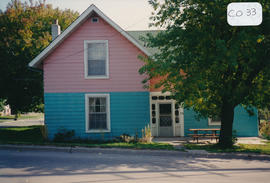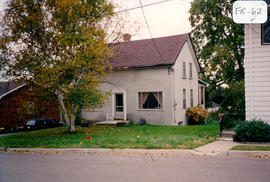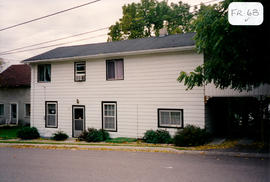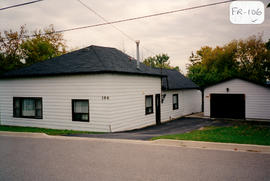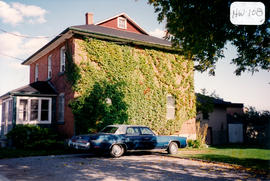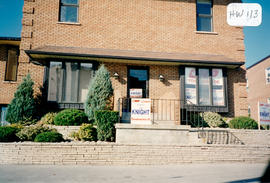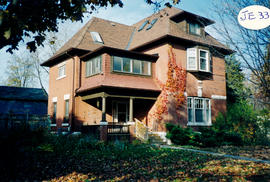41 Simcoe Road - The Dr. Clement House
- CA BWGPL GJ-HB-2017-04-21-05
- Pièce
- 1995
Fait partie de George Jackson fonds
The Dr. Clement House is located at 41 Simcoe Road (on the southeast corner of Simcoe Road and Centre Street). It was built around 1830-1860 (1840’s?) in the Classic Revival style. Dr. Clement lived and died here after practising in the 1870-80’s. He was buried in Clement Cemetery on the 2nd Line in Innisfil (east of Highway 11). His wife Rachel lived here until her death. The house was then rented to Walton, a railroad man for the C.N.R. The barn and garden behind the building ran to William St. (as did all the properties on the east side). Sam Catania and his wife Sarah lived here in later years. They converted the house into two apartments and had a dry cleaning business in the garage that was eventually destroyed by fire. Sam sold the house to Bruce and Barbara Verney. They were still living here when this photo was taken in 1995. Bruce was a chiropractor. A building used as a dry cleaner was constructed later on the property. Jack Pong (a restaurant owner on Holland St.) built a house on the back of this property that extended to Centre Street.
The street level has apparently been raised considerably around this house as the current 1½-storey, two-bay house was originally 2½ storeys. It has an asymmetrical façade and entrance, a simplified ‘temple’ form, and a medium-pitched, gable roof. The pediment roof shape has return eaves facing the front. A hip roof on the raised entrance portico is supported on wood beams with decorative, wood dentils. The corner columns have wooden ‘flutes’ and are mounted on brick pedestals. A wood-panelled door is flanked by narrow sidelights and is topped by a transom light. The house has small window openings with low floor to ceiling heights. Small, upper-floor windows are set into rectangular openings with plain, wood frames and sills. A ground-floor, bay window is an angled projection with a hip roof. The brick masonry foundation appears to be a replacement. A horizontal belt line at the top of the foundation is expressed with wood trim. The structure has wood frame construction with stucco cladding and a cut-stone foundation. Bricks found at the bay window foundation and at the entrance porch are probably not original. According to the 2000 inventory, the house is in good condition with many original details. (1, 2, 3, 4)
Sans titre


